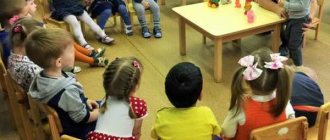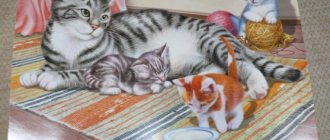Summary of GCD on physical development in the middle group
Author: Khmarina Elena Valentinovna
Summary of GCD on physical development in the middle group
Objectives:
Educational:
Exercise children in walking one after another, in a snake, lining up in a circle, walking with high knees, and doing pull-ups on a gymnastic bench.
Developmental:
Develop agility, endurance, motor activity.
Educational:
Cultivate interest in physical development activities, a sense of mutual assistance, and a friendly attitude.
Health savings
: Strengthen the respiratory system, promote the formation of correct posture, hardening the body, and prevent flat feet.
Equipment:
Gymnastic benches, sandbags, musical accompaniment, basket with a letter, rope.
1 part.
Progress of the NOD:
Children enter the hall to the music and form a circle.
Educator:
“Do you guys like fairy tales?
(Children's answers)
Do you want to go to a fairy forest?
(Children's answers)
Let's go together along the path into the forest! “The children follow the teacher and follow each other in a circle. The music ends and the children stop.
Educator:
“Here we come to the forest. Hello forest, dense forest! Full of fairy tales and miracles! There’s a swamp ahead... How can we get through it?” Sandbags are laid out in front of the children to get through the “swamp”; children step over the bags.
Educator:
“Try to walk in such a way that you don’t go off the road.” When everyone has overcome the obstacle, the teacher picks up a pre-prepared basket with a letter in it.
Educator:
“We walked through the swamp and found the basket!” They read the letter: “There was a little house in the forest, animals lived there, and when I got to them, the little house suddenly fell down! Help! Help! Give us back the little house!”
Educator:
“Let's help the animals!
(Children's answers)
To do this, you need to find a clearing and build a tower! Go ahead! There is a river in front of us, we need to cross the bridge!” Children approach the bench.
Educator:
“There is a bridge on the way that you have to crawl along! Reach straight with your hands and grab the bridge! Don’t put your feet down, raise your head up!” Children approach the stream (rope).
Educator:
“We can’t go any further, a stream is babbling on the way! Raise your legs higher, step over the stream!” They move on like a snake.
Educator:
“There’s a clearing ahead, the sun is shining! It also helps the guys in the forest!”
Part 2.
ORU:
1.
Starting position
- legs together, hands on the belt.
Educator:
“We looked at the sun, and the rays warmed us!”
Children on their toes reach for the “sun” (4-6 times) 2. I.p - legs together, arms to the sides. Educator:
“The breeze flies by, the trees in the forest sway.” Tilt left to right (8-10 times).
3. Starting position
- legs together, arms down.
Educator:
“Look at the bottom guys, there are mushrooms growing - honey mushrooms! We must also collect them and then give them to the animals.” Bend forward (6-8 times).
Educator:
“We had a good walk and weren’t tired at all! We’ll take the tools and build a home for the animals.”
ATS:
1.
“Sawing”
-
Starting position
: arms bent at the elbows, legs apart.
We imitate the movements of a saw. 2. “Chop”
-
Starting position
of the arm above the head in a lock, legs apart.
Bend forward, swing your arms between your legs. 3. “We hammer in nails”
-
Starting position:
legs together, hands on the belt. On the count of 1,2,3,4, children perform jumps.
Educator:
“So the little mansion has grown, It is not low, not high!
Animals will live in it! Who will live there? (Children's answers.)
Children imitate the movement of animals from a fairy tale.
Part 3.
Educator: “The butterflies have arrived and warmed their wings!”
Outdoor game “Butterflies and the Sun”. (Sun - butterflies fly, rain - butterflies stop and hide their wings.)
Reflection.
Educator:
“We were all friendly, brave, skillful, and so we built a little house in a fairytale forest!
Now it’s time for us to return” comments powered by HyperComments
Motor mode model for all age groups
Health care – to ensure the protection of the life and promotion of the child’s health. Contribute to the improvement of all functions of the child’s body.
Educational – to form the foundations of physical culture. To form in children initial ideas about healthy lifestyle.
Educational – to cultivate interest in various types of motor activities. To promote the development of positive volitional qualities in the child.
| Motor mode model for all age groups | Junior groups | Middle groups | Senior groups | Preparatory groups |
| Morning exercises | Daily 5-6 min. | Daily 6-8 min. | Daily 8-10 min. | Daily 10-12 min. |
| Physical education minutes | 2-3 min. | 2-3 min. | 2-3 min. | 2-3 min. |
| Music classes | 2 times a week 15 min. | 2 times a week 20 min. | 2 times a week 25 min. | 2 times a week 30 min. |
| Physical education classes (2 indoors, 1 outdoors) | 3 times a week 15 min. | 3 times a week 20 min. | 3 times a week 25 min. | 3 times a week 30 min. |
| Outdoor games: - plot games; - plotless; - fun games; - competitions; - relay races. | Every day at least two games for 5-7 minutes. | Every day at least two games for 7-8 minutes. | Every day at least two games for 8-10 minutes. | Every day at least two games for 10-12 minutes. |
| Health activities: - awakening gymnastics - breathing exercises | Daily 5 min. | Daily 6 min. | Daily 7 min. | Daily 8 min. |
| Physical exercises and game tasks: - articulation gymnastics; — finger gymnastics; - visual gymnastics. | Daily, combining exercises of your choice for 3-5 minutes. | Daily, combining exercises of your choice for 6-8 minutes. | Daily, combining exercises of your choice for 8-10 minutes. | Daily, combining exercises of your choice for 10-15 minutes. |
| Physical education | Once a month up to 15 min. | Once a month up to 20 min. | Once a month up to 30 min. | Once a month up to 40 min |
| Sports festival | 2 times a year up to 30 min. | 2 times a year up to 45 min. | 2 times a year up to 1 hour | 2 times a year up to 1 hour |
| Independent motor activity of children during the day | Daily. The nature and duration depend on the individual characteristics and needs of the children. Conducted under the guidance of a teacher. | |||
Motor mode of the younger group
| Kind of activity | Duration |
| Morning exercises | Daily in a group (in the warm season - on site), 5 min |
| Motor warm-ups | Every day during 10 min. break between classes |
| Physical education minutes | Daily during static exercises, 2-3 min. |
| Outdoor games and exercise while walking | Daily 15-20 min. |
| Individual work on movement development | 2 times a week for a walk of 5-10 minutes. |
| Exercising after a nap | Daily 5-6 min. |
| Physical education classes | 2 times a week for 15 min. |
| Sports walk | 3 times a week for 10 -15 minutes |
| Physical education | Once a quarter, 20-25 min |
| Independent motor activity | Every day, under the guidance of a teacher, indoors and on a walk, the duration depends on the individual characteristics of the children |
Motor mode of the middle group
| Kind of activity | Duration |
| Morning exercises | Daily in a group (in the warm season - on site), 5-6 minutes |
| Motor warm-ups | Every day during a 10-minute break between classes |
| Physical education minutes | Daily during static exercises, 2-3 min. |
| Outdoor games and exercise while walking | Daily 15-20 min. |
| Individual work on movement development | 2 times a week for a walk of 5-10 minutes. |
| Exercising after a nap | Daily 5-6 min. |
| Physical education classes | 2 times a week for 20-25 minutes. |
| Sports walk | 3 times a week for 15-20 minutes |
| Physical education | Once a quarter, 20-25 min |
| Sports holiday | 2 times a year, 45 min. |
| Independent motor activity | Every day, under the guidance of a teacher, indoors and on a walk, the duration depends on the individual characteristics of the children |
Motor mode of the senior group
| Kind of activity | Duration |
| Morning exercises | Daily in a group (in the warm season - on the site), 6-7 min. |
| Motor warm-ups | Every day during a 10-minute break between classes |
| Physical education minutes | Daily during static exercises, 2-3 min. |
| Outdoor games and exercise while walking | Daily 20-25 min. |
| Individual work on movement development | 2 times a week for a 15-minute walk. |
| Exercising after a nap | Daily 5-6 min. |
| Physical education classes | 2 times a week for 30 minutes. |
| Sports walk | 3 times a week for 15-20 minutes. |
| Physical education | Once a month, 30 min |
| Sports holiday | 2 times a year, 1 hour |
| Independent motor activity | Every day, under the guidance of a teacher, indoors and on a walk, the duration depends on the individual characteristics of the children |
Motor mode of the preparatory group
| Kind of activity | Duration |
| Morning exercises | Daily in a group (in the warm season - on site), 6-7 minutes |
| Motor warm-ups | Every day during a 10-minute break between classes |
| Physical education minutes | Daily during static exercises, 2-3 min. |
| Outdoor games and exercise while walking | Daily 20-25 min. |
| Individual work on movement development | 2 times a week for a 15-minute walk. |
| Exercising after a nap | Daily 5-6 min. |
| Physical education classes | 2 times a week for 35 minutes. |
| Sports walk | 3 times a week for 20-25 minutes |
| Physical education | Once a month, 35-40 min. |
| Sports holiday | 2 times a year, 1 hour |
| Independent motor activity | Every day, under the guidance of a teacher, indoors and on a walk, the duration depends on the individual characteristics of the children |
Tasks. Exercise children in walking and running in a column, one at a time and scattered; in the ability to act on a signal; develop dexterity and eye when rolling the ball with both hands.
Part I. Walking in a column one at a time, alternating with running; walking and running in all directions. Formation in 3-4 circles.
Part 2. Game exercises.
"Don't miss the ball." Children form 3-4 circles (circles are drawn on the ground or laid out from cords). In the center of each circle there is one driver with a ball (large diameter) in his hands (at a distance of about 2 m from the players). The starting position for all players is to stand with their feet apart. At the teacher’s signal, each driver rolls the ball to one of the players, who bends down and with both hands, folding them into a “scoop,” rolls the ball back. Then the driver rolls the ball to the next player, etc. After some time, other drivers are appointed. The teacher monitors the children’s actions and compliance with the rules - do not step beyond the designated line, accurately direct the ball to a partner.
“Don’t touch me.” Jumping on two legs between objects (cubes, skittles, medicine balls) placed in one row (40-50 cm from one another). Distance 3-4 m. The game task is performed in two columns (2 times).
Outdoor game "Cars". Each player receives a steering wheel (cardboard or plywood). At the teacher’s signal (the green flag is raised), the children scatter in all directions so as not to interfere with each other. At another signal (a red flag is raised), the cars stop. The game repeats itself.
Part 3. Game "Let's find the little sparrow."
Lesson 4
Tasks. Teach children to push off energetically from the floor and land on bent legs when jumping up, reaching for an object; practice rolling the ball.
Part I. Walking and running in a column one at a time, stopping at the teacher’s signal. The teacher explains the task; while walking he says: “Bunnies!”, the children stop and jump on two legs in place, then continue walking. After walking, switch to running. Walking and running in alternation. Reorganization in three columns.
A lesson marked with two asterisks (**) is conducted on the playground (or indoors, depending on weather conditions) in the form of game exercises.
Part 2. General developmental exercises with flags.
1. I. p. - stand with feet as wide as your feet, flags down. Raise the flags forward, up, look at the flags, lower them, return to the starting position (5-6 times).
2. I. p. - stand with feet as wide as your feet, flags at the shoulders. Sit down, touch the floor flags with the chopsticks, stand up, return to the starting position (5-6 times).
3. I. p. - stand with feet shoulder-width apart, flags down. Turn right (left), flags to the sides, return to the starting position (5-6 times).
4. I. p. - sitting, legs apart, flags at the chest. Bend forward, touch the floor between your toes, straighten, return to the starting position (5-6 times).
5. I. p. - legs slightly apart, flags are folded and lie at the toes. Jumping on two legs in place, alternating with walking (count 1-8), repeat 3 times.
Main types of movements.
1. Jumping “Get to the object” - jumping in place on two legs. Performed by a series of jumps 3-4 in a row, then a pause and jumps again at the teacher’s signal (3-4 times).
2. Rolling balls to each other (distance 2 m). Method - kneeling, sitting on your heels (10-12 times for each group).
The teacher places two stands and pulls the cord along the hall so that all the children complete the task at the same time. Children are positioned on both sides of the cord; perform jumps in turns at the command of the teacher. The teacher explains the task in advance: “You need to approach the cord, wave your arms, push off vigorously, jump and reach the ribbon (ball, bell) with your hand.
Children stand in two lines at a distance of 2 m from one another; children in one line have balls in their hands. At the teacher’s command: “Let’s go!” - children roll the balls to the opposite side several times in a row with energetic movements of their hands.
Outdoor game "Planes". Children stand in several columns on different sides of the hall. The place for each column is indicated by an object (cube, pin, medicine ball). The players portray pilots. At the teacher’s signal: “For flight!” - children perform circular movements with their arms bent in front of their chest - “start the engines.” At the next signal: “Let's fly!” - children raise their arms to the sides and run - “fly” in different directions throughout the hall. At the signal: “Landing!” - “airplane” children find their place (at their cube) and line up in columns.
Part 3. Walking in a column one at a time.
Report “Development of motor activity of children under the conditions of the introduction of Federal State Educational Standards” in the middle group
STRUCTURAL DIVISION "KINDERGARTEN No. 4 OF A COMBINED TYPE" MBDOU "KINDERGARTEN "RADUGA" OF A COMBINED TYPE" OF RUZAEVSKY MUNICIPAL DISTRICT
Report
“Development of motor activity of children under the conditions of the introduction of the Federal State Educational Standard”
middle group
educators: T.N. Abramushkina
E.A. Sorokina
Ruzaevka 2021
Motor activity is the natural need of children to move, the satisfaction of which is the most important condition for the harmonious development of the child and his state of health.
Probably no one doubts that movement is of great importance in a child’s life. Indeed, when he moves - walks, runs, jumps, throws a ball, rides a bicycle, etc., his breathing accelerates, his heart beats faster, which means that the body works better, the processes of growth and development are activated.
The motor activity of a preschooler must correspond to his experience, interests, desires, and functional capabilities of the body. Therefore, teachers need to take care of the organization of children’s motor activity, its diversity, as well as the fulfillment of the main tasks and requirements for its content.
The teacher’s task is to intensify interest in movement, teach how to control movements, enrich the composition of movements and the content of motor activity in general, and develop motor creativity.
Physical activity promotes:
— increasing the body’s resistance to various diseases;
— growth of physical performance;
— normalization of the activity of individual organs and functional systems;
- the emergence of positive emotions that promote mental health.
Motor activity is a type of activity in the educational field “Physical Development” and represents forms of organization of motor activity
In all forms of motor activity, as a rule, a complex of interrelated tasks is solved: health-improving, educational and educational. Health-improving tasks are aimed at creating a healthy lifestyle and cultivating a conscious attitude towards the manifestation of one’s physical activity. When developing the content of educational tasks, it is important to pay attention to the development of independence, activity and communication, as well as the formation of the emotional, moral and volitional sphere of children in the process of motor activity. The formation of pupils' need for physical activity occurs: during routine moments, in organized children's activities, in independent children's activities, and in interaction with families.
Increasing physical activity during the day helps meet the child's needs for movement. This condition requires the teacher to carefully consider and clearly organize the children’s routine:




